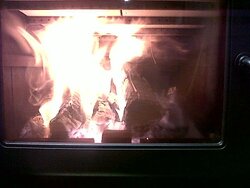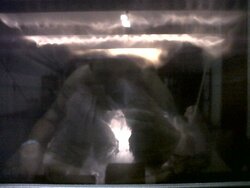Wood Duck said:
fire_man said:
joefrompa said:
lol
I actually peal the bark off every piece of my pine. Compared to every other wood, pine bark seems to work hard at trapping moisture under the entire wood surface. I find the pieces season vastly faster and it takes very little additional effort to peal some substantial pieces of bark off them each time I stack a piece.
I weigh the effort this way too: is it less effort to peal the pine bark off now then to struggle with a fire for 15 minutes in the winter months because it's got a pile of moisture under the bark to burn off.
Finally, somebody posted something I barely have read about on Hearth.com, but experienced many times. Bark DOES tap moisture! I have had many VERY annoying fires that I struggled with, using 2 year seasoned Beech but the tarp leaked in a few spots and the wood got wet. The wood itself was well seasoned but peeling the bark back revealed a soaking wet layer of wood under a soaking wet layer of bark. I know some will say the leaky tarp trapped moisture, letting moisture in but preventing it from evaporating, but I don't buy it. At least with semi-lose Beech bark (and evidently also Pine according to joefrompa), any water that gets in there has a hard time getting back out and leads to struggling with the fire. So I say top covering is better than no cover, and peeling bark is not a waste of time. One exception, the first year of seasoning (before the bark gets lose) , its better to go uncovered.
I have many times peeled the bark off an otherwise dry piece of wood on a dry day to find moisture beneath the bark. I peel away all the bark I can easily peel, but there is a limit to the effort I will put into peeling. The limit is somewhere in the 2 second range.
I don't have experience with alot of different types of wood. Mainly pine, ash, elm, and ironwood. Here's my experiences with each:
1. Ironwood bark falls off very shortly after being bucked into rounds. It's not a moisture problem.
2. Ash bark falls off in beautiful sheets and I piece it off as it's thick and wonderful kindling. The underside WILL trap moisture against the wood if it's not removed, even if it's loose against the wood. But it takes no effort to remove.
3. Elm bark is similar to ash.
4. Pine bark is best left on the pine for a few months. After that, even in round form, it'll peel off pretty easily. I found that having a sharp edge (sharpened stick, small knife) makes it a piece of cake to start the peeling process. It traps a massive amount of moisture underneath, despite being very thin bark. Also, leaving the bark off for kindling - if the bark is exposed to rain, it absorbs the water. The bark stays wet, period. Unless kept completely dry, it's terrible kindling. The splits seem to season MUCH better and faster without the bark.
...
I love pine. It's one of the most forgiving of woods. It burns easily, fast, and hot. It seasons very fast. But it's a really wet wood - when green, it doesn't burn well. It seems to absorb moisture much more readily than other woods. It's bark traps moisture. Etc.
Pine is extremely satisfying for me to burn, as it raises the temp of my stove like a skyrocket and I can put in large splits almost immediately after kindling light off. So for me, when the pine struggles, it's a real pain. It'll kill an otherwise good launch. My stove will start to smoke and hover at 350. And I'll wind up fiddling with it and trying to find small pieces that will fit around the bad piece(s) of pine to get the stove going again.
What I've found this year is that I left my pine in various piles or in rounds for awhile - few weeks to few months. When I finally went to split it or stack it, the bark on alot of pieces had partially peeled off. So I simply took the chance to peel it all off.
In all cases, the bark underneath was a hotbed of moisture and bugs. TONS of those white larvae in there. And further, when I stripped it off, I usually increased the exposed surface area of the wood by 50% (it had 2 exposed sides, not it has 3). So seasoning time for that split would go from maybe 4 months down to 2-3 months (Yes, that fast).
....Anyway, that's my story. I've probably spent an extra 30-45 minutes total de-barking alot of splits in 2-3 cords of pine. I figure that'll easily pay off if it simply saves me the frustration of fiddling with 3-4 fires that otherwise wouldn't have gone sa well.





 ! PLEASE.
! PLEASE.